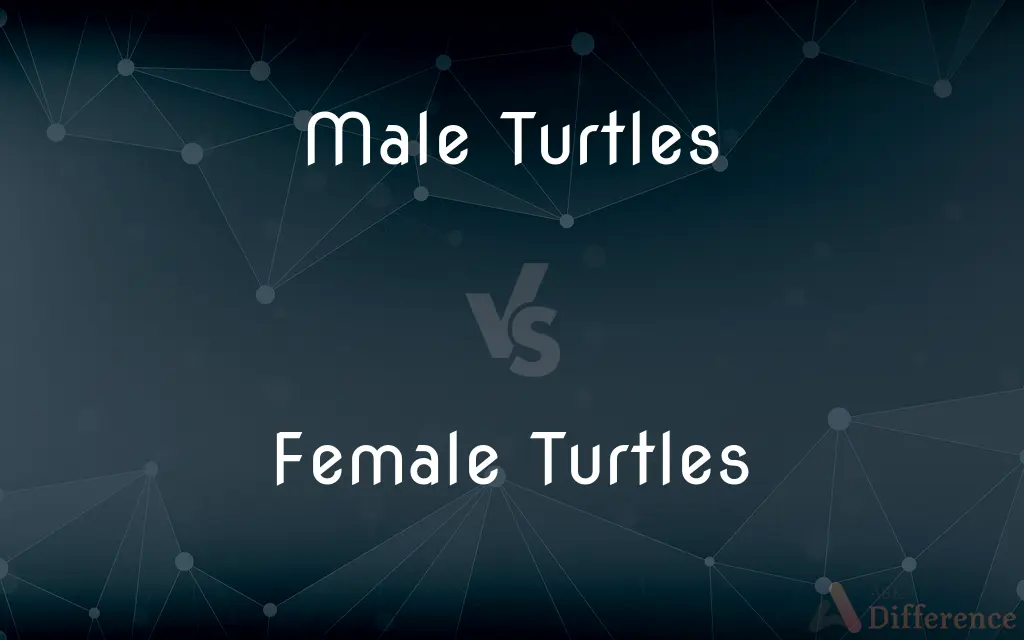Male Turtles vs. Female Turtles — What's the Difference?
By Tayyaba Rehman — Published on January 29, 2024
Male turtles often have thicker, longer tails and concave plastrons, while female turtles generally have shorter tails and flat or convex plastrons for egg-laying.

Difference Between Male Turtles and Female Turtles
Table of Contents
ADVERTISEMENT
Key Differences
Male and female turtles can be differentiated by several physical characteristics. Male turtles typically have longer, thicker tails because their reproductive organs are located at the base of the tail. Female turtles, in contrast, have shorter, thinner tails as they do not require extra space for reproductive organs.
The shape of the plastron (the bottom shell of a turtle) is another distinguishing feature. Male turtles usually have a concave plastron which helps them mount the female during mating. Females usually have a flat or slightly convex plastron which provides more space internally for carrying eggs.
In many turtle species, males also tend to have larger, more ornate claws on their front limbs, which they use in courtship displays and to grasp the female during mating. Females typically have shorter, more functional claws not used for such displays.
Size can also be an indicator, though it varies by species. In some turtle species, females grow larger than males, which is advantageous for laying eggs. In other species, males and females are more similar in size, making other characteristics more important for distinguishing between both.
Behaviorally, male turtles are often more aggressive and territorial, especially during the breeding season. Female turtles generally exhibit behaviors focused on nesting and egg-laying, such as spending more time on land looking for suitable places to lay eggs.
ADVERTISEMENT
Comparison Chart
Tail Size
Longer, thicker
Shorter, thinner
Plastron Shape
Concave
Flat or convex
Claw Size
Larger, ornate (in some species)
Shorter, functional
Size (varies by species)
Often smaller
Often larger (for egg-laying)
Behavioral Traits
More aggressive, territorial
Focused on nesting, egg-laying
Compare with Definitions
Male Turtles
Feature a concave plastron.
You can identify male turtles by their concave plastrons.
Female Turtles
Female turtles have shorter, thinner tails.
The female turtle's tail is notably shorter than the male's.
Male Turtles
Can be more aggressive and territorial.
The male turtle exhibited territorial behavior during mating season.
Female Turtles
Feature a flat or slightly convex plastron.
Female turtles' plastrons are more suited for egg-laying.
Male Turtles
Size varies, sometimes smaller than females.
In this species, the male turtles are smaller than the females.
Female Turtles
Focused on nesting and egg-laying behavior.
The female turtle spends time on land to find a nesting site.
Male Turtles
Often have larger, ornate claws.
The male turtle used his large claws during the courtship display.
Female Turtles
Have shorter, more functional claws.
The female turtle uses her claws for digging nests.
Male Turtles
Male turtles have longer, thicker tails.
The male turtle's tail was distinctly longer than the female's.
Female Turtles
Often larger in size for carrying eggs.
Female turtles of this species are larger to accommodate egg-laying.
Common Curiosities
Why do male turtles have longer tails?
To accommodate their reproductive organs located at the base of the tail.
What is the purpose of a concave plastron in male turtles?
It helps the male mount the female during mating.
Are female turtles always larger than males?
Not always, but in many species, females are larger for egg-laying purposes.
Why do female turtles have flatter plastrons?
To provide more space internally for carrying eggs.
Why are female turtles sometimes more aggressive?
Females can be protective, especially when nesting or caring for eggs.
Do male turtles use their claws for courtship?
Yes, in some species, male turtles have ornate claws for courtship displays.
How can you tell a male turtle from a female?
By observing the tail size, plastron shape, claw size, and sometimes overall size.
Are there any color differences between male and female turtles?
Generally, no significant color differences are present.
How do male and female turtles differ in aquatic species?
Similar differences in tail size and plastron shape are observed.
Do both male and female turtles lay eggs?
No, only female turtles lay eggs.
Share Your Discovery

Previous Comparison
Rump Roast vs. Chuck Roast
Next Comparison
Cayenne Pepper vs. Chili PowderAuthor Spotlight
Written by
Tayyaba RehmanTayyaba Rehman is a distinguished writer, currently serving as a primary contributor to askdifference.com. As a researcher in semantics and etymology, Tayyaba's passion for the complexity of languages and their distinctions has found a perfect home on the platform. Tayyaba delves into the intricacies of language, distinguishing between commonly confused words and phrases, thereby providing clarity for readers worldwide.













































